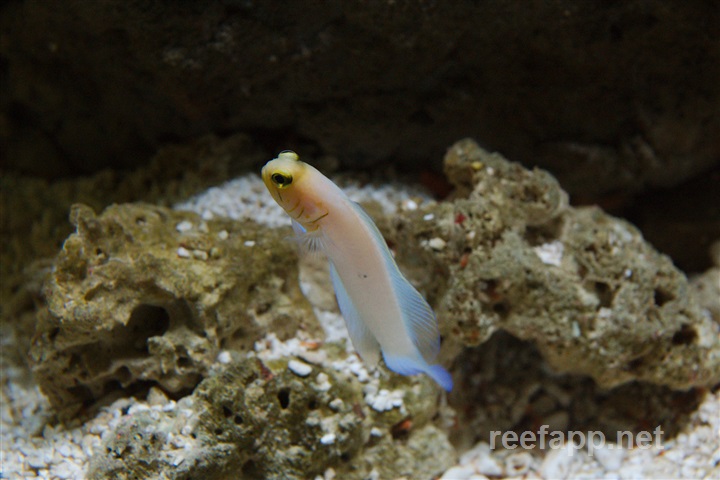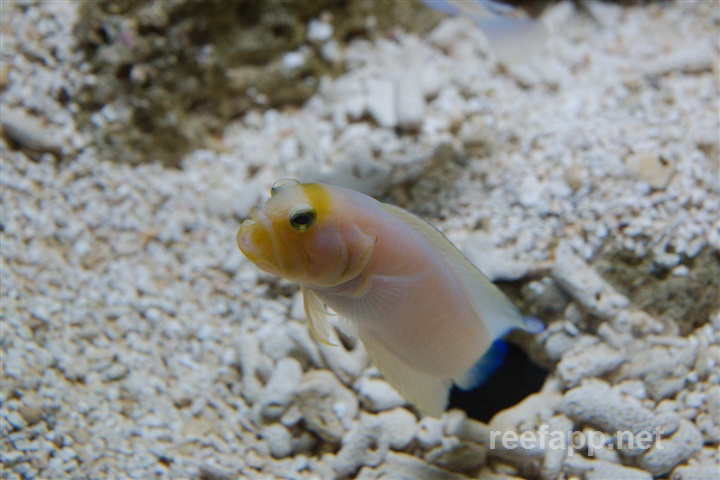Opistognathus aurifrons


| Latin name | Opistognathus aurifrons - (Jordan & Thompson, 1905) |
|---|---|
| Local name | Yellowhead Jawfish |
| Family | Opistognathidae - Opistognathus |
| Origin | The Mexican Golf, West Atlantic |
| Max length | 10 cm (3.9") |
| Minimum volume |
200 l (53 gal) |
|---|---|
| Hardiness |
Hardy |
| Suitable for aquarium |
Suitable with care |
| Reef safe |
Always reef safe |
| Aggressiveness | Docile but might be aggressive towards similar species |
| Recommended |
Small crustaceans (Krill, mysis, artemia...) Zooplankton (Cyclops, pods...) |
|---|
This species is known to jump out of open aquaria.
These fish prefer a substrate which allows it to burrow.
A substrate consisting of sand, coral pieces, shells and small pieces of broken up shells is ideal for them to dig holes in.
One can also arrange rocks to enable the fish to create a hole underneath, making certain they are secure and cannot fall over.
There should be space to enable them to make a hole which is at least 1½ inch (3 cm) longer than their own body.
Other animals digging in the sand, can stress this species, if the aquarium is not spacious enough. Be therefore aware of, for example of Wrasses which burrow at night.
The male incubates the eggs in its mouth.
This species often has a fun and interesting personality.
This species can function in large numbers down to just one.
This species is very shy and docile, so one should be careful when keeping it with more aggressive fish.
This species can be bred in captivity, one can therefore consider asking your local fish store for a captive bred specimen.
There should be a minimum of 2 inch (5 cm) between each Jawfish's cave if one wishes to keep more than one.
A Jawfish couple will sometimes "dance" when mating.
Jawfish (Opistognathidae) live in a small hole, and therefore require a deep sand substrate.
When given the right conditions, one has a good chance for success with keeping them, as Jawfish are fairly easy and hardy. One should not however add them to an aquarium with aggressive fish or others which dig in the sand, unless there is enough space.
Jawfish are known for hopping out of the aquarium, even through the smallest holes. This occurs when they do not have enough time to find a hole before the lights are turned off, so one should try to make a hiding place for them, when newly introduced.
Jawfish will sometimes gasp for air at the surface until they have made a hole. If this behaviour continues, it could indicate that the surroundings are not suitable or that the Jawfish is being disturbed by the other fish, this must be solved in order for the fish to survive.
| Aquarium trade | Yes |
|---|---|
| Distribution | Western Central Atlantic: southern Florida, USA and Bahamas to Barbados and northern South America. |
| English common names |
Yellowhead jawfish |
| Danish common names |
Gulhovedet kæbefisk |
Scott W. Michael. 2001. Basslets, Dottybacks & Hawkfishes: v. 2 (Reef Fishes) - TFH Publications / Microcosm Ltd. - (English)
Henry C. Schultz. 2002. Let's Jaw About Jawfish - Reefkeeping Magazine - (English)
Bob Fenner. Jawfishes, Family Opistognathidae - Wet Web Media - (English)

